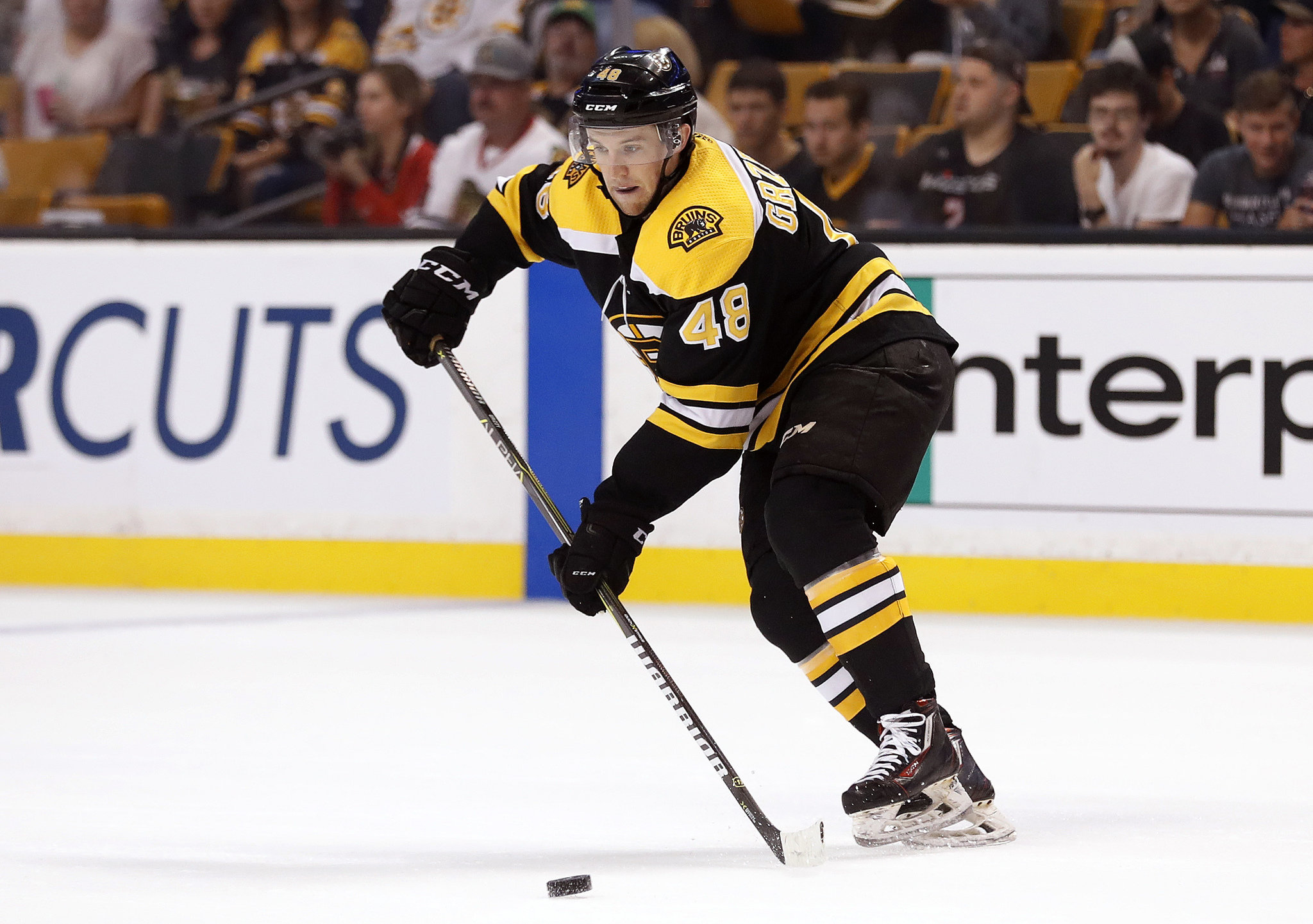
By: Spencer Fascetta | Follow Me on Twitter @PuckNerdHockey
Take a look at the Bruins’ defense corps this year. 300-year-old Zdeno Chara is logging significant minutes, while his toddler of a partner, Charlie McAvoy, looks like he’s been in the league for nearly a decade. I’ve already gone in-depth with our good friend Brandon Carlo, which you can read here, but he is a steady, young, Top 4 guy. Torey Krug is one of the most dynamic blueliners in the game, which I discuss in depth here. If anyone told you Kevan Miller had developed into a reliable two-way weapon, you would have booked them a one-way trip to a mental institution. Adam McQuaid, well, you can read my feelings on him here. They really haven’t changed much since then. They just made a deal for Nick Holden, who I give some thoughts on here. You forgot Paul Postma existed. That leaves Matt Grzelcyk, the pint-sized Boston native who forced his way into the lineup halfway through the season and has made quite the case to remain there.
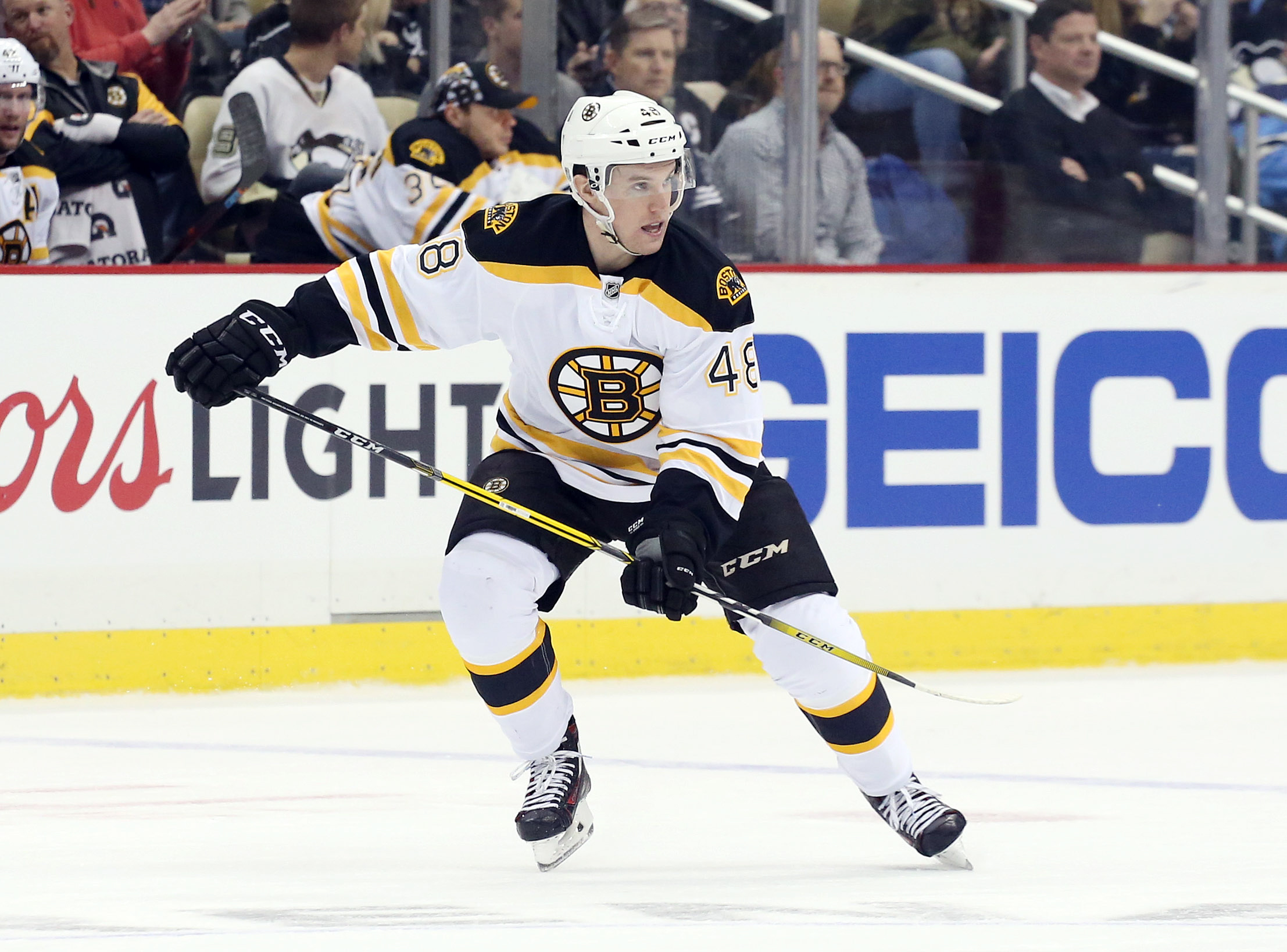
Photo: Charles LeClaire/USA TODAY Sports
That being said, there seems to be a bit of groupthink that Grzelcyk is not very good, and not only should be a nightly scratch in favor of McQuaid or Holden but that he probably doesn’t have a long-term future on the Bruins. There are a few contributing factors here. For one, he’s small. The Boston fan base has had the privilege of watching Torey Krug work his magic for the past 5 years, and have thus developed an unrealistic expectation that every undersized defenseman should be in that mold. To this point, Grzelcyk certainly has not displayed the level of dynamics Krug has. As I have stated in previous articles, I also feel as if the Boston fanbase clings to it’s Big Bad Bruins heritage like it’s a liferaft. Unfortunately, that liferaft has a 3-foot gash in the side of it and has been sinking faster and faster as the years have gone on. It is one of the reasons they are infatuated with Adam McQuaid, despite the countless pieces of information that state he is a below-replacement-level option.
In that vein, I thought I’d put together another one of my excessively long pieces on Matt Grzelcyk to convey to you, the reader, how good he actually is. As always, I used the fabulous database available at Corsica.hockey, and compiled them filtered datasets into my own massive database, simply for the ease of manipulation. This particular data was gathered on March 22nd, 2018, and I limited the data to any defenseman who has logged at least 500 minutes of ice time thus far this season. This, in theory, limits the dataset to defensemen who have played at least half of the season at the NHL level. The secondary dataset is comprised of the pairings data from Corsica, looking at the four players Grzelcyk has spent significant time with as a defense partner this year – Brandon Carlo, Adam McQuaid, Kevan Miller, and Charlie McAvoy. The visuals are created through Tableau. If there is size scaling on the graphs below of the marks, it is by time on ice (pairings data) and time on ice percentage (individual data), the percentage of a team’s total time on ice a player is used in. Phew! That’s a long preamble. Told you I had a rambling tendency!
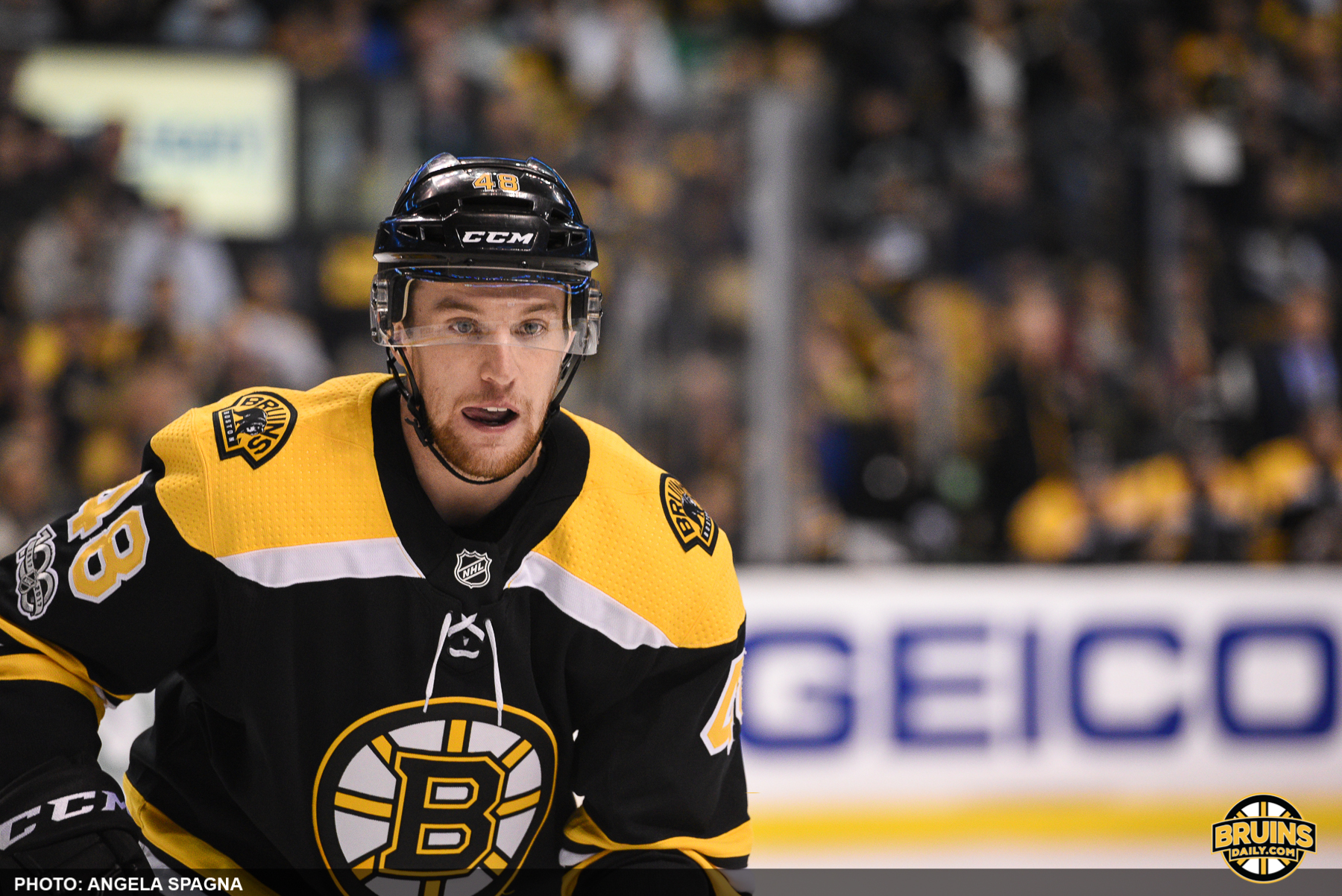
Photo: Angela Spagna
Let’s get started by looking at the individual-player data. The first graph depicts the relationship between Corsi For per Hour (CF/60) and Corsi Against per Hour (CA/60). Corsi For per Hour is describes shot attempts generated for a player’s team while they are on the ice per every 60 minutes of play, and Corsi Against per Hour is the opposite – the number of shot attempts allowed by a player’s team while they are on the ice. This isolates a player’s impact on shot attempt generation in the offensive and defensive zones. In general, you want your CF/60 to be higher than 50, and your CA/60 to be below 50. Defensemen spend more time in their own end than forwards, and overall more time on the ice than forwards, so it makes sense to see that a majority of them are +50 CA/60 players. It’s a positive that so many defensemen are +50 CF/60 players as well. This would indicate that a majority of defensemen in the NHL who reach at least 500 minutes played are competent two-way players.
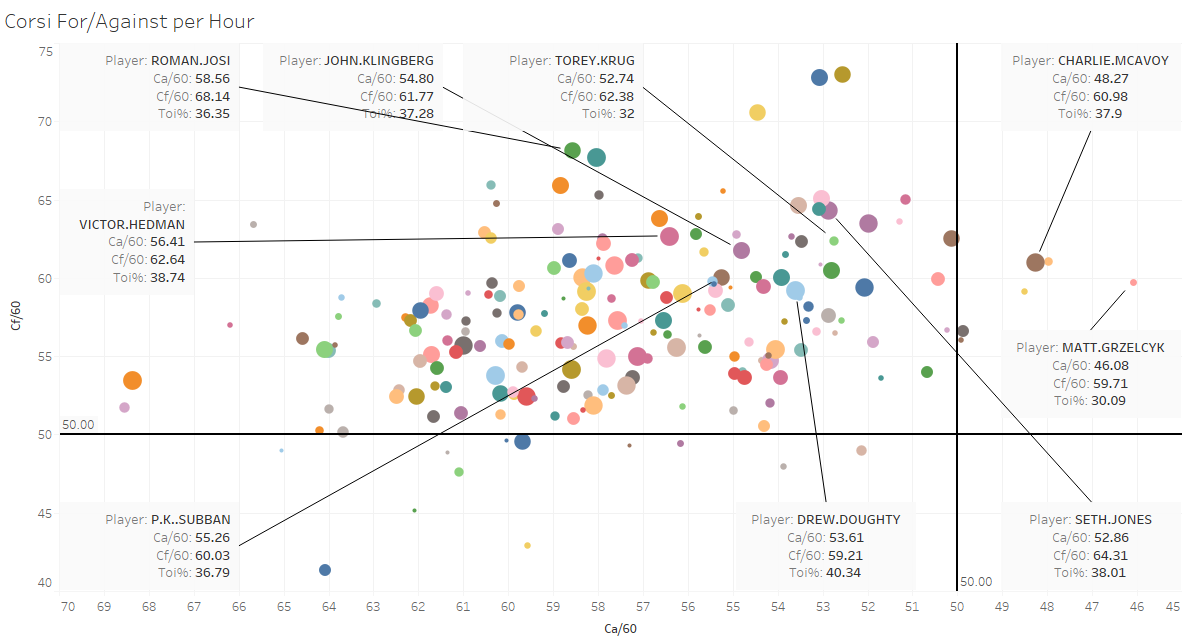
What you will likely find interesting is that there are two Bruins I have highlighted that are -50 CA/60 players in addition to being +50 CF/60 players (there are in fact 3, Kevan Miller also falls in this range, but is much, much closer to the 50% line) – Matt Grzelcyk and Charlie McAvoy. Every other marked player on this graph is a presumptive Norris Trophy candidate this season. So, what does this mean? Well, it means that McAvoy and Grzelcyk are both quite good at generating shots for their team, but they are able to balance that with being two of the best shot suppression defensemen in the entire NHL – as rookies. Not only that but Grzelcyk, at least according to this measurement, is the BEST (no, that is not a typo) shot suppression defenseman in the entire NHL. This comes with two caveats. For one, he has not played a full season in the NHL yet. In addition to that, when he has been in the NHL this season,a he hasn’t started to receive Top 4 minutes until the past week and a half, and that elevation in playing time was in direct response to the rash of injuries the team has suffered of late. Both of these facts contribute tomaller sample size than I would have liked. Regardless, the fact remains that he is a premier defensive defenseman at this point in his career.
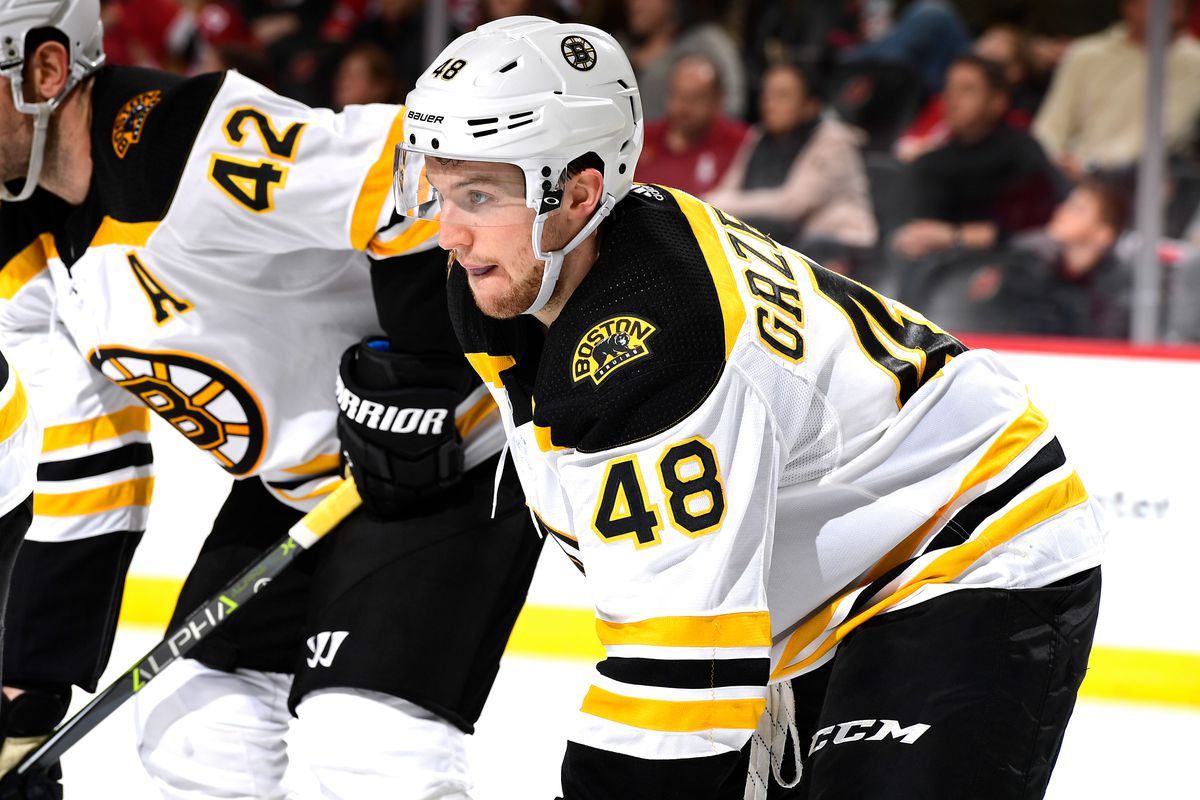
Photo: Steven Ryan/Getty Images
“But, wait!” you exclaim. “You just said he wasn’t getting significant minutes, he’s probably being sheltered!” Aha! I see you come prepared. So, I adjusted CF/60 and CA/60 by the quality of competition. This analyzes the CF/60 and CA/60 of all of the players who have been on the ice for the other team at the same time as the player in question. Based on this, Grzelcyk falls around the middle of the pack. You can see that Charlie McAvoy and Torey Krug play some of the toughest minutes in the NHL, and Grzelcyk is not a massive amount behind the two. By no means does he play “sheltered” minutes; he just doesn’t have to try to shut down the league’s best on a game to game basis.
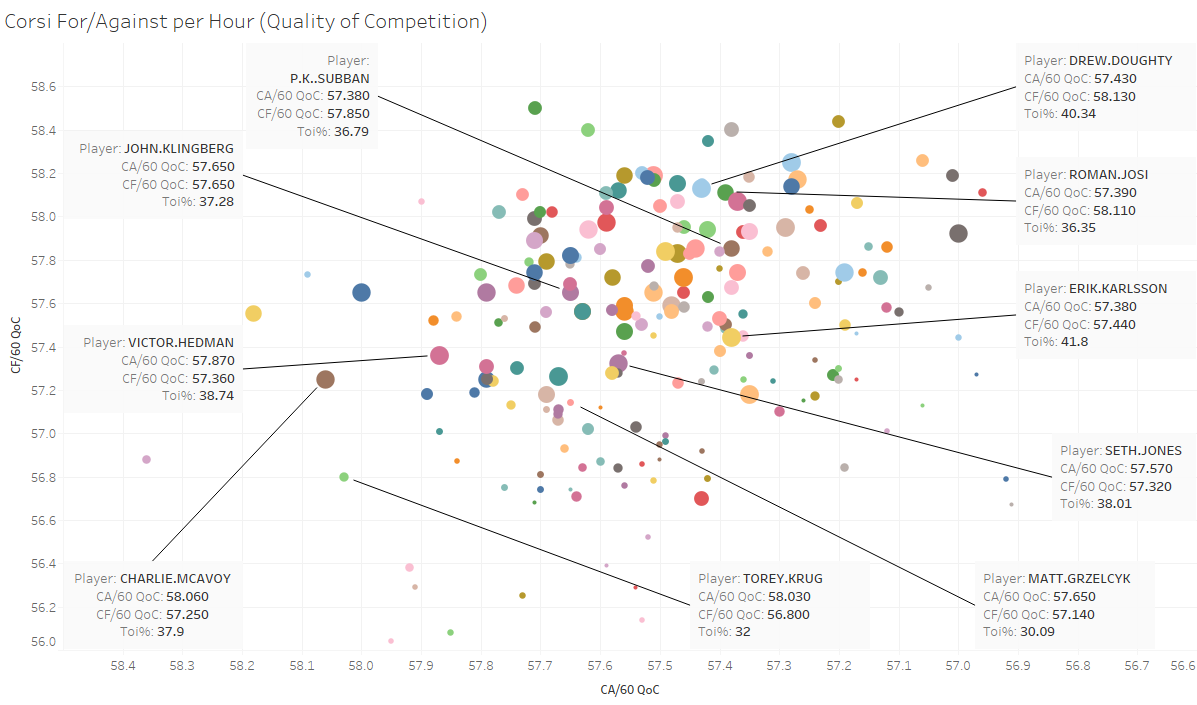
Let’s take a peek at the kind of players Grzelcyk has played with so far. Based on this graphic, yes, Grzelcyk does seem to have the benefit of playing with strong teammates. This should come as no surprise – the Bruins have (arguably) the best defensive forward of all time in Patrice Bergeron, and are consistently a strong defensive team. However, he falls in a similar range as McAvoy and Predators captain Roman Josi.
**Sidenote: I feel really badly for Erik Karlsson. Nobody has been forced to play with worse defensive players than him this year, and it isn’t even close. He hasn’t gotten a ton of help offensively thus far either. Looks like Ottawa may want to buckle up, this may take a while to fix.
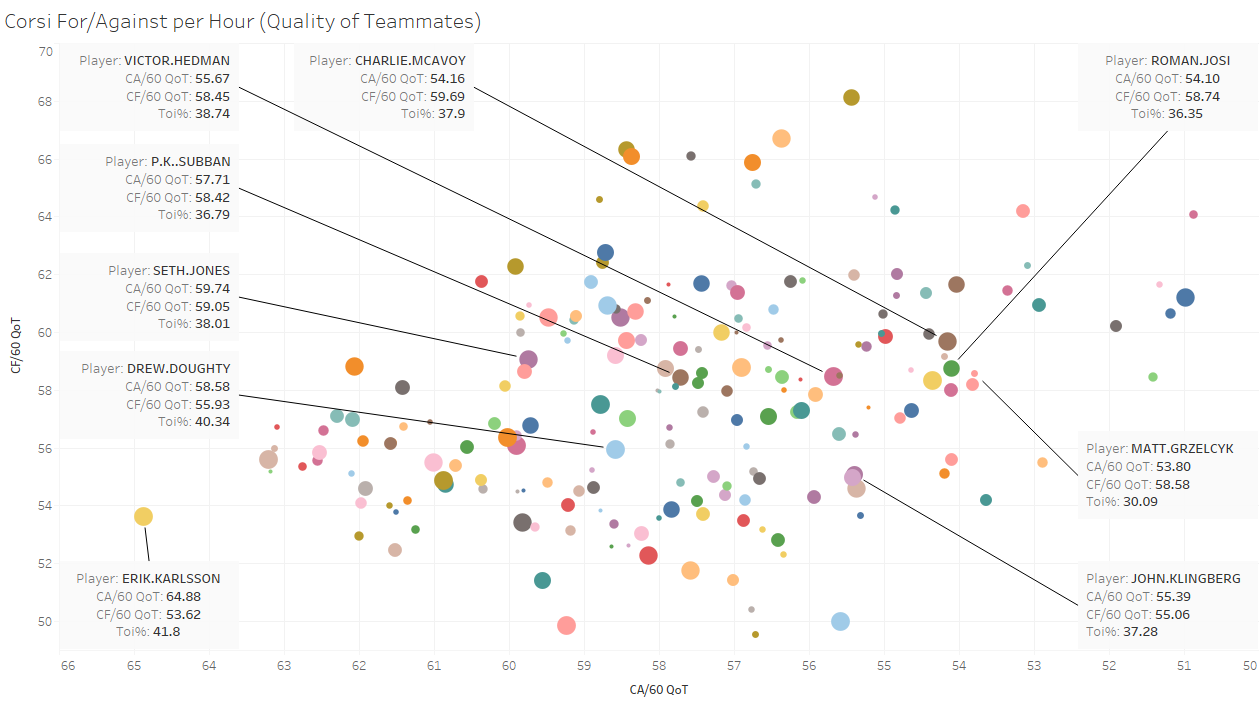
Let’s take a look at how efficient this group is at converting its expected goal output. Grzelcyk far outpaces the field in this case – he has far and away the highest goals for the percentage of this group, which is a measure of the number of goals that are scored by his team out of all goals scored while he is on the ice. Grzelcyk is near 75% – meaning the Bruins have scored 3/4 of the goals scored while he has been on the ice. His expected goals for percentage is still well above 50%, which tells me that although some regression should be expected, it should not be quite as extreme as one would think.
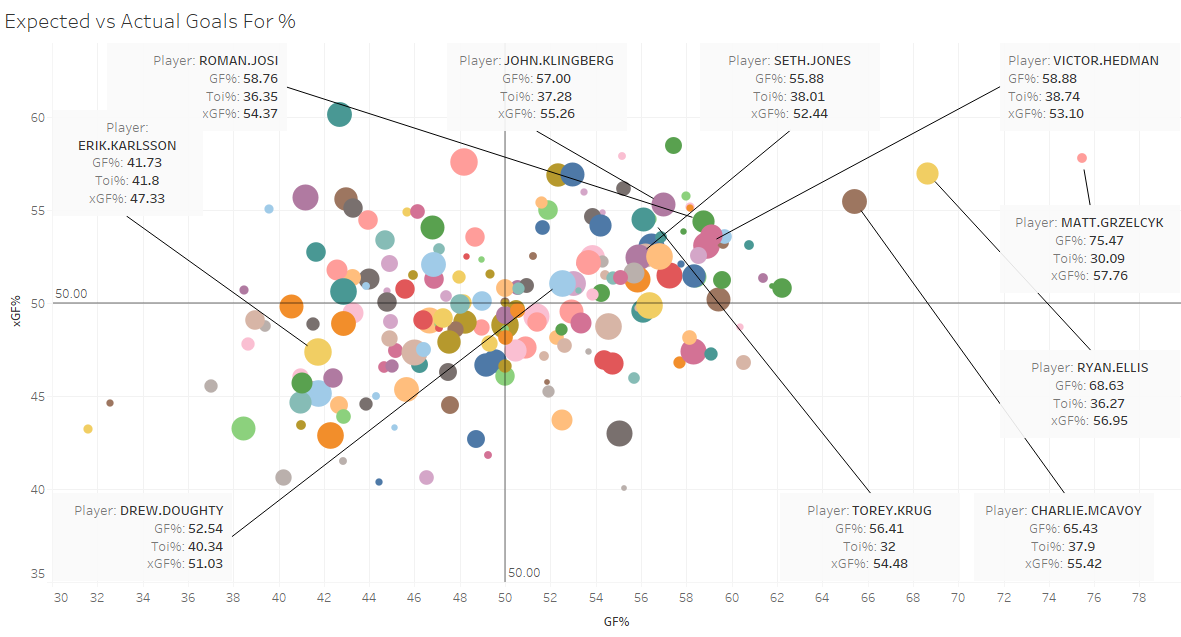
We’ve discussed his impact on both shots for and against, but how well does he take care of the puck? Well, let’s take a look at takeaways and giveaways per hour. Surprisingly, he falls into the defensively sound quadrant here, as he averages more takeaways than giveaways per hour. Contrast that with Norris candidates such as Drew Doughty, who falls into the risky quadrant (more giveaways than takeaways), and Grzelcyk falls firmly into the upper echelon of NHL defensemen. He actually is better at taking the puck away from his opponents than Charlie McAvoy, Victor Hedman, PK Subban, Torey Krug, John Klingberg, and the aforementioned Doughty. Pretty good company.
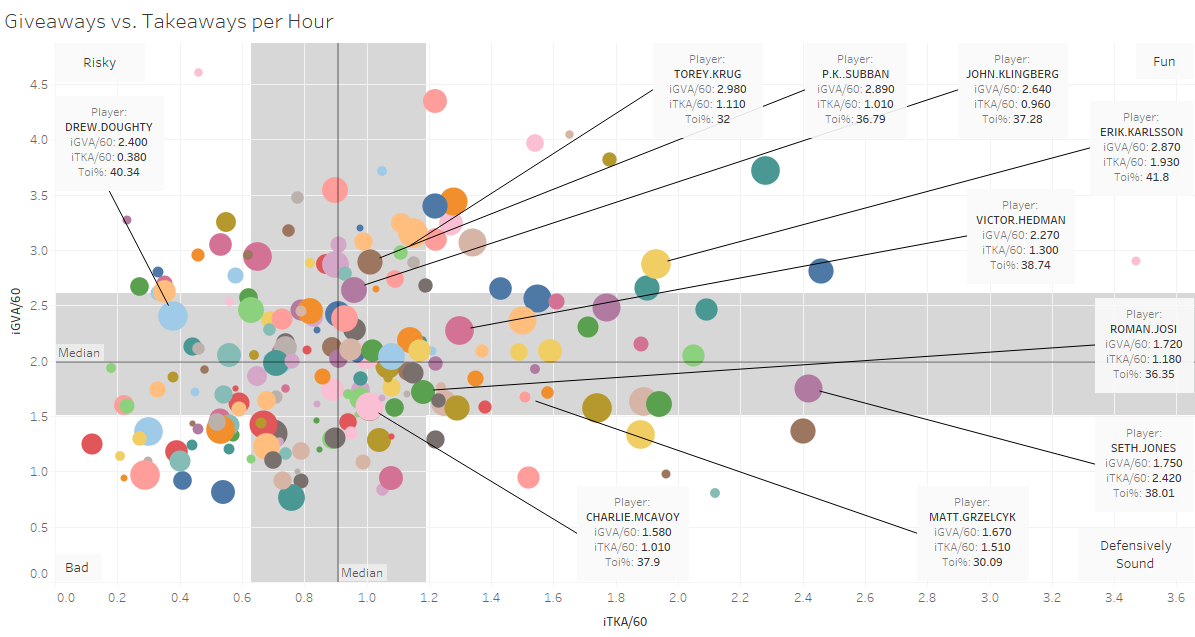
Well, is he benefitting from sheltered zone starts? As compared to his peers, only slightly. I want to point a few things out though. He gets SIGNIFICANTLY fewer offensive zone starts than Torey Krug (who, rather absurdly, gets nearly half of his zone starts in the offensive zone), and in fact, receives fewer than Charlie McAvoy. Additionally, he is THE BEST defenseman concerning shots for percentage, which is the percentage of all shots taken by his team out of the total number of shots taken while he is on the ice. When he’s on the ice, the B’s are taking nearly 60% of the shots.

I mentioned earlier that Grzelcyk had benefitted from playing with high-end defensive-forwards such as Patrice Bergeron and Brad Marchand. But what about his defensive partners? Well, looking at CF/60 and CA/60 of the 4 defensive pairings he has been a part of, all of them fall into the -50 CA/60 and +50 CF/60 quadrant. He and McAvoy may be one of the most dominant defensive pairings we have seen in Boston in quite a while.
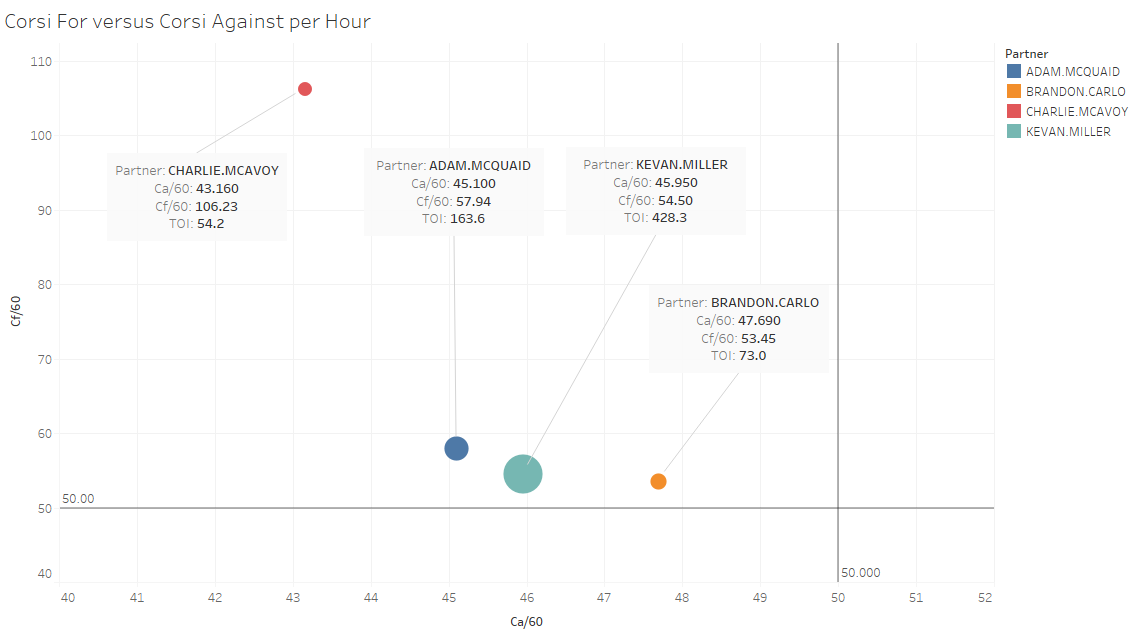
How dominant is the McAvoy/Grzelcyk pairing? The former Boston University Terrier teammates have nearly 90% of the goals scored by either team while they are on the ice. He did the impossible and made Adam McQuaid look like an offensive threat. Kevan Miller has been a brilliant compliment.
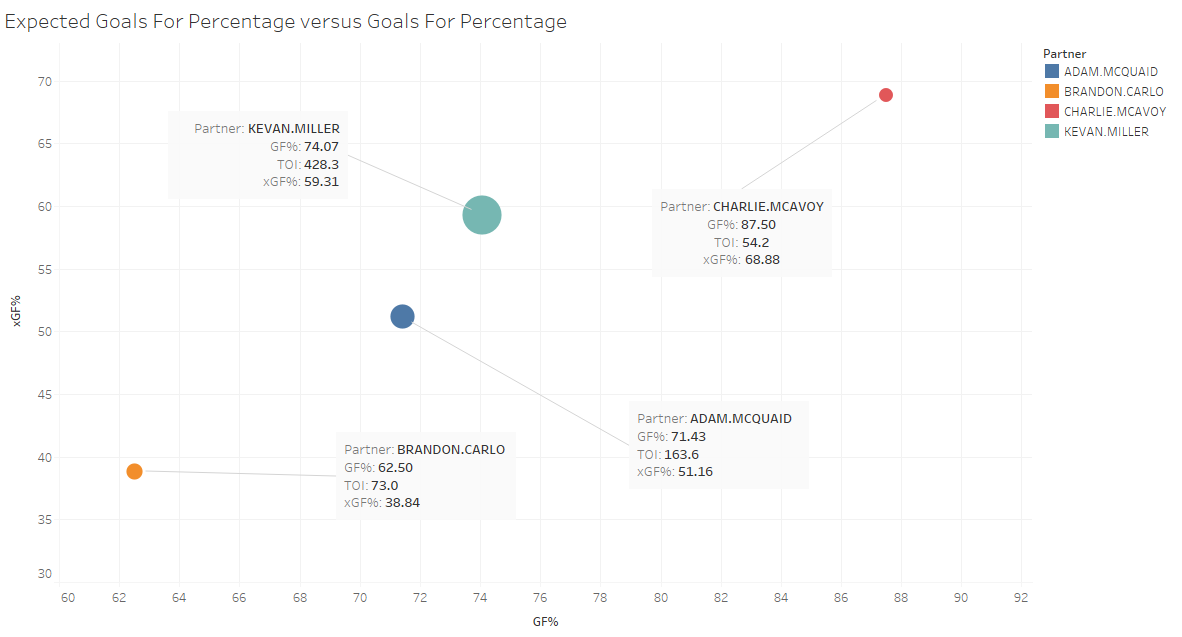
Let’s take a look at their Corsi differential and Shot Differential. He and Carlo give up more shots than they generate, and are *ahem* less than good regarding Corsi. While the McQuaid pairing is decent as it pertains to shot differential, they are not very good regarding possession. Unsurprisingly, the McAvoy/Grzelcyk duo has been good in both aspects. However, the more surprising thing might be the sheer dominance the Miller/Grzelcyk pairing has shown. They are comfortably a definite possession pairing, but they obliterate the competition when it comes to shot differential. That’s absurd.
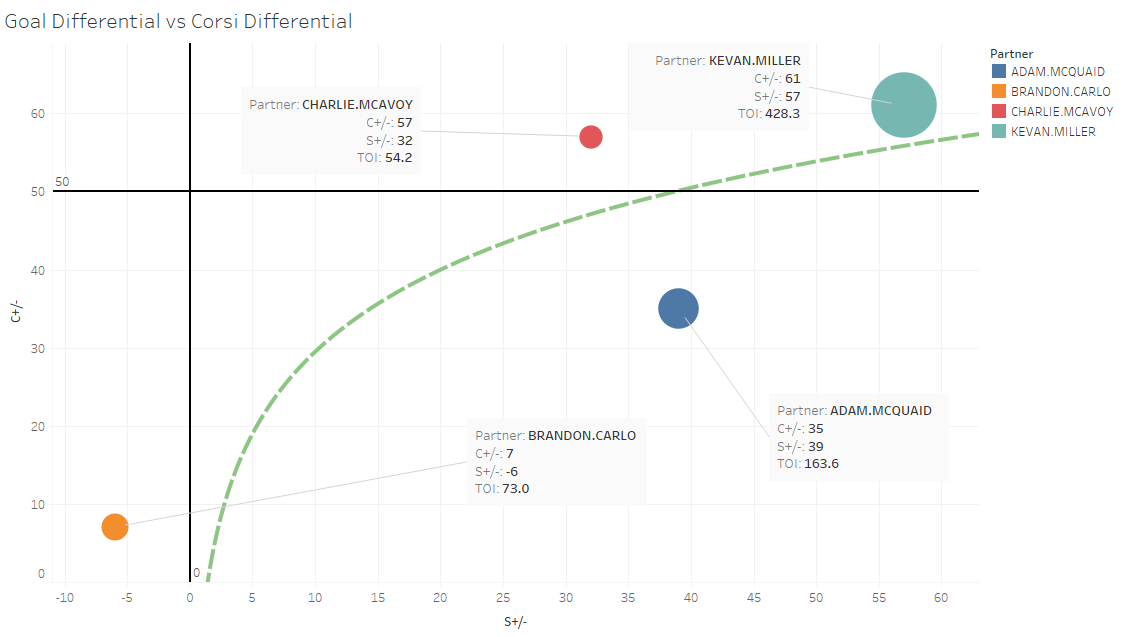
Who’s still with me? Well, congratulations – you’re one of the few. Let’s attempt to take all of this information, and answer the question I posed at the beginning: What do the Bruins have in Matt Grzelcyk? Based on my statistical analysis, Grzelcyk looks like an elite two-way defenseman, which is excellent at taking the puck away from his opponents and one of the best in the league at shot generation and production. Based on the vaunted eye-test, I see a young defenseman who realizes he is undersized and is able to use a ludicrously high hockey IQ to compensate for his physical limitations. His stick positioning is consistently brilliant, and he might make the best outlet pass in the league. No, that’s not hyperbole. He seems to be gaining confidence offensively, but he is a little tentative when it comes to jumping up into the rush. I expect this will come with time and experience. Grzelcyk might be the 2nd best defensive prospect the Bruins have, and I’m aware of how ridiculous that sounds. But yes, I think he’s better than Jakub Zboril, better than Jeremy Lauzon, better than Urho Vaakanainen, and better than Brandon Carlo. It’s not overly close. The only thing standing in his way is the perception that he is just another small defenseman.
Enjoy this piece? Check out my work here, and consider taking a gander at my YouTube Channel, where I react to most Bruins games, and discuss NHL news with an analytics twist. Feel free to like, share, and subscribe!


0 Comments
1 Pingback